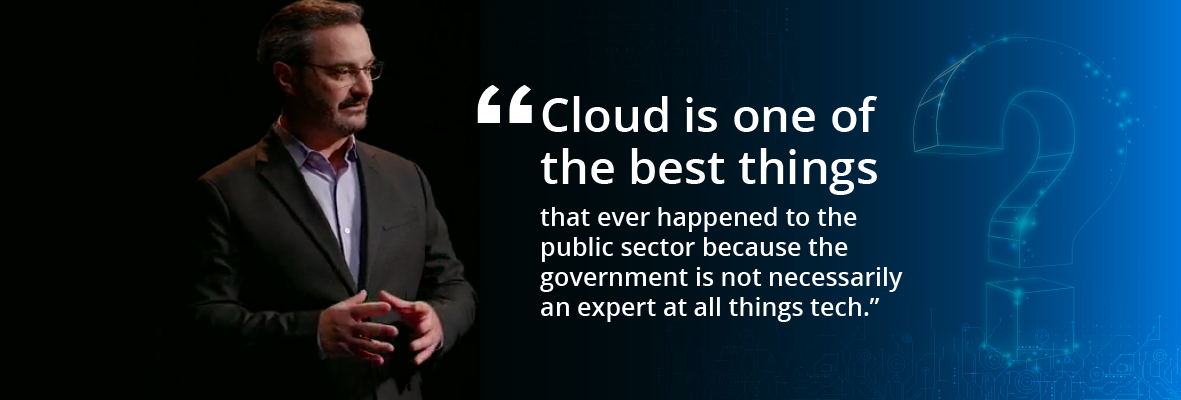Today on the blog we feature a conversation with Jonathan Reichental, an award-winning former CIO who now travels the world to speak, teach, and consult on emerging trends including the fourth industrial revolution, urban innovation, the future of cities, and blockchain technology. We got his take on cloud adoption and digital disruption in government:
OpsRamp: What’s the state of digital innovation in government?
JR: Technology has traditionally been an afterthought in government but now it is moving to the center of all activity. I was the CIO of the City of Palo Alto for seven years, from 2011 to 2018. The timing was remarkable. For the first time, governments were using technology to make it easier for community members to access data. We witnessed the beginning of the app economy, where citizens could use apps to report crimes or issues in the streets like a pothole.
Today we’re seeing very sophisticated apps, such as for making a permit request or one-city apps that include all the government activities and information a citizen may need in one place. In Dubai for instance, there is the DubaiNow app that has 70 city services. In the last decade, we have moved on to digitalization. Cities are thinking about what services they can put online to cover a range of things, from reducing costs to making the government experience better.
"Technology has traditionally been an afterthought in government but now it is moving to the center of all activity."
OpsRamp: To what degree have governments embraced the cloud?
JR: In 2011, the cloud was barely a topic of discussion in government. But today, finally, the cloud is a big deal. Cloud is one of the best things that ever happened to the public sector because the government is not necessarily an expert at all things tech. Governments struggle to pay compensation rates that attract the best experts in tech.
But now with the cloud, government IT departments can outsource storage, maintenance, applications and websites and focus on what they’re good at, which are things like project management, service management, and vendor relationships. We are starting to see the big players like AWS, Microsoft and Google having government-certified storage and security. Cloud providers are finally ensuring that they meet all the specific federal, state and local government requirements.
Cloud is helping to enable not only greater digitalization, but also bringing the Internet of Things (IoT) capabilities to cities. That means everything from smart security cameras to air and noise monitors, traffic management, autonomous vehicles, and sensors for water management.
"Cloud providers are finally ensuring that they meet all the specific federal, state and local government requirements."
OpsRamp: What are the biggest differences in private versus public sector adoption of cloud applications, platforms, and infrastructure?
JR: It’s mostly maturity. There are a lot of legacy systems in government, so there’s some heavy lifting. This is not easy work and procurement cycles and integration challenges are not trivial. The private sector has the luxury to build from the ground up and throw stuff away or create new things because companies have to move quickly as the market dictates.
Government architecture has often evolved haphazardly. It is not well-designed and integrated, so the environment is more complex to move major government processes to the cloud. In some ways, the government has a tougher time, and this is going to take a few years. Eventually, governments will be in a much better position to deliver more agile and responsive services to citizens.
OpsRamp: What are the data management strategies that governments are pursuing?
JR: They are hiring data scientists and big cities are hiring chief data officers. Just this year I’ve seen a growing volume of vendors in the space and greater recognition of the role of data governance. Jonathan talks more on data management in government here:
OpsRamp: What are some cool things you’ve seen lately in government tech?
JR: Dubai and UAE have made technology a centerpiece of who they are. In particular, I like the paperless initiative. By 2022, the goal is to have no more paper in government. Everything will be digital. This is great for the environment and efficiencies, but it also can eliminate redundant processes and do things better. It’s transforming their government.
Another one is a digital twin project in Singapore. A digital twin is a virtual replica of a physical thing. The government has created a $75 million solution to render the entire city digitally. You can see traffic conditions, energy use in buildings, scenarios for a shutting down a road, or if water gets cut in an area. Finally, the city of Sacramento was first in the nation to deploy 5G technology. We don’t know yet what will be the full impact of 5G, but it will enable high-speed and high-bandwidth connectivity.
I think this will bring greater convenience to citizens and help them to do things like connect autonomous vehicles or deliver notifications for when the trash needs to get picked up. This is likely going to make significant inroads in lowering costs and increasing the scale of wireless-based innovation.
Next Steps:
- Read the Digital Enterprise Journal report: The Roadmap to Becoming a Top-Performing Organization in Managing IT Operations.
- Learn how you can move to the cloud without losing your mind: OpsRamp can help.
- Schedule a custom demonstration of the OpsRamp platform.






